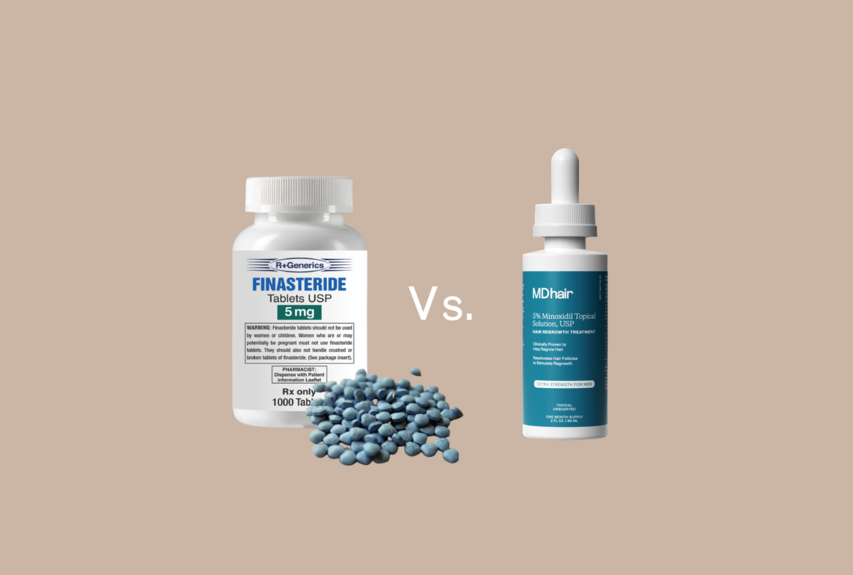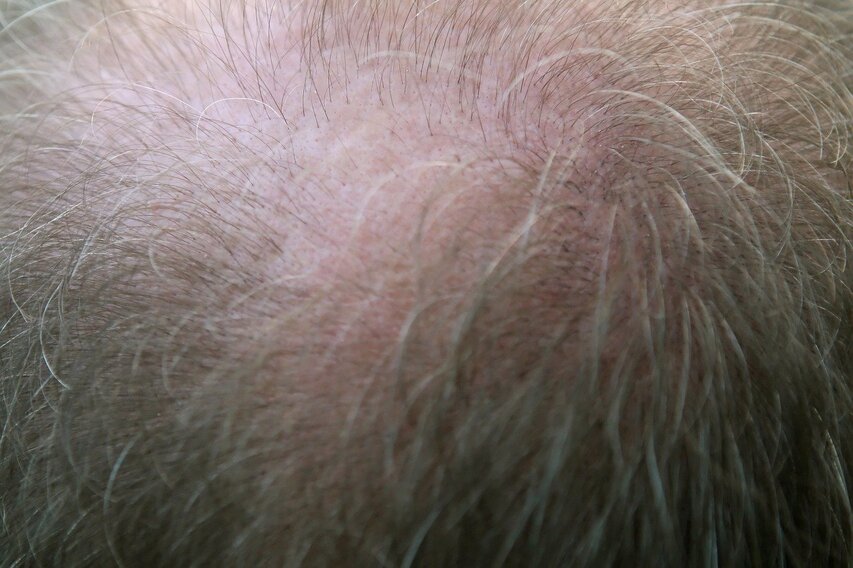Minoxidil or Finasteride for male hair loss?
Hair loss is a common problem affecting men and women. Two out of three men will experience some form of male pattern baldness by 35 years old. Androgenetic alopecia, or male pattern baldness (MPB), is caused by DHT, a hormone that affects hair follicles. In men's tendency for hair loss, an excess of DHT causes the hair follicles at the hairline and crown to shrink. This process starts early and can be found in 20% of men in their 20s and 30% in their 30s.
Two common treatments are clinically proven to help hair loss: Finasteride and Minoxidil. With regular use, both of these products can help slow down male pattern hair loss (also known as androgenetic alopecia) and help promote hair regrowth. Although both of these products achieve the same goal, they work differently. Let's break down the differences between Finasteride and Minoxidil.

What is male pattern balding?
Male pattern baldness, known as androgenetic alopecia, is men's most common hair loss. One cause of this condition is genetics; if there is a family history of baldness, especially on the mother's side, you are more susceptible.
Research has found that male pattern baldness is connected to male sex hormones called androgens. These androgens can affect many things within the body, including regulating hair growth and loss.
Male pattern baldness can begin as early as the teenage years, but it's more commonly found in adult men. Some men find their hair loss starts at the temple or crown of the head, while others notice it in a single spot or a receding hairline in the form of an "M" shape.

What is the difference between minoxidil and finasteride?
Minoxidil and finasteride are two of the most researched and well-known hair loss treatments available. Both are approved by the Food and Drug Administration (FDA) and backed with scientific research, though significant differences exist between the two.
What is minoxidil?
Minoxidil is an over-the-counter vasodilator. It is an over-the-counter topical medication available in liquid or foam form. When applied to the affected areas of the scalp, it helps to widen the blood vessels, encouraging blood flow to the hair follicles. The increased blood flow delivers more essential nutrients and oxygen to the area, promoting hair growth.
What is finasteride?
Finasteride is an oral medication initially developed to treat prostate enlargement and cancer. Finasteride is typically used for male hair loss. However, it is not approved for use in women due to the possibility of congenital disorders. Side effects may include dizziness, headache, gastrointestinal discomfort, excessive facial and/or body hair growth, and sexual dysfunction.
How does minoxidil work?
Minoxidil works by widening the blood vessels in the head and increasing blood flow to the area. It stimulates hair growth by lengthening the hair cycle's anagen phase (growth phase) to encourage healthier, thicker growth. Technically, topical minoxidil does not stop hair loss. Instead, it promotes growth by triggering hairs in the resting phase (telogen phase) to shed so they can be replaced with new hairs that may start to take on a healthier, thicker appearance.
Recent studies have suggested that in addition to its direct effects on scalp blood circulation, it can help with hair regrowth in a few more ways:
-
Induction of vascular endothelial growth factor (VEGF) expression increases vascularization around the hair follicles, thus contributing to hair growth.
-
Activation of the prostaglandin-endoperoxide synthase one, which stimulates hair growth.
-
Inhibition of androgen effects on the androgen-sensitive hair follicles.
-
Minoxidil may act as an 'epidermal growth factor' on matrix cells, delaying their aging, thus prolonging the duration of the anagen phase via the activation of the beta-catenin pathway.
-
Anti-scarring properties are secondary to its effect on collagen synthesis.
Minoxidil - clinical studies
Numerous studies have demonstrated the efficacy of using it to promote hair growth. In a year-long study involving 904 males with male pattern hair loss, 62% of the participants experienced a significant reduction in the affected area of their scalp when they applied 5% topical minoxidil twice a day. Additionally, 84.3% of patients reported varying degrees of hair regrowth. Comparatively, the 2% and 5% minoxidil solutions resulted in a 70% greater improvement in average hair density compared to a placebo over 16 and 26-week treatment periods. In a randomized control trial (RCT) involving 278 patients, those treated with the 5% solution exhibited a 45% higher hair regrowth rate than those using the 2% solution after 48 weeks.
The overall incidence of side effects associated with minoxidil usage is relatively low and not typically serious. Consistent use of minoxidil does not appear to result in resistance to its effects. When used correctly, patients can expect hair growth within 4-8 months, stabilizing after 12-18 months. However, progressive hair loss can be anticipated within 12-24 weeks if treatment is discontinued.
Are there side effects of minoxidil?
Since minoxidil disrupts your hair's growth cycle, users may shed more during the first few months of growth. This is a normal side effect that will pass with time. Other common side effects include dryness, itching, flaking, and slight scalp irritation.
How does finasteride work?
Finasteride is categorized into a class of medications called 5-alpha-reductase inhibitors. It works by blocking the effects of 5-alpha-reductase, which converts testosterone into DHT within the body. As mentioned, DHT is the primary hormone causing male pattern baldness.
Finasteride is a shield that protects the follicles from being exposed to DHT in the first place. It is praised for preventing male pattern baldness from worsening while protecting the existing hair.
Finasteride - clinical studies
Scientific literature has demonstrated the effectiveness of finasteride in treating patients with AGA (androgenetic alopecia), and long-term usage for up to 5 years has shown significant hair growth and permanent stabilization of hair loss. It is noted that the drug is more effective in treating baldness at the vertex (crown area) rather than the frontal scalp, and it is recommended to continue using finasteride indefinitely to maintain the hair salvaged by the initial treatment. Over time, the efficacy of finasteride appears to improve, and in some cases, consistent use has shown further improvement. In a well-known large-scale study involving over 3000 males with AGA in Japan, it was found that 11.1% of subjects experienced significant hair regrowth with finasteride use, 36.5% experienced moderate growth, and 39.5% had a slight increase in hair growth over three years.
Are there side effects of finasteride?
Finasteride may cause many side effects, including loss of interest in sex, erectile dysfunction, and mood changes. Other possible side effects are trouble having an orgasm, abnormal ejaculation, swelling in the hands and feet, tenderness or lumps in the breasts, dizziness, weakness, headache, runny nose, and skin rashes. The sexual side effects of finasteride may continue after stopping taking this medicine. Consult with your local physician if you have concerns about these side effects.
In rare cases, finasteride can cause serious side effects that require immediate medical attention. These include severe allergic reactions that can cause trouble breathing, swelling of the throat or tongue, or hives.
A recent study of 3,282 finasteride users used VigiBase, the World Health Organization's global database of individual case safety reports, and found a disproportional prevalence of suicidality, depression, and anxiety associated with finasteride use for alopecia in patients younger than 45 years. No such signs were related to medications with different mechanisms of action but similar indications or medications with similar mechanisms and adverse effect profiles.
People with liver disease or prostate cancer should not use finasteride. Finasteride is metabolized in the liver. In people with liver disease, the body processes the medication more slowly, increasing the medication levels and causing more side effects. Finasteride can also increase the risk of faster-growing or more aggressive forms of prostate cancer. If you have or have had prostate cancer, you should not take finasteride.
Is finasteride spray safe?
The FDA does not approve finasteride spray for hair loss treatment. Some websites mix it with minoxidil and sell it off-label. Adding finasteride to the minoxidil can be associated with more side effects than using the minoxidil solution. The finasteride spray is safer but can cause the same side effects as oral finasteride, including sexual dysfunction, headaches, etc.
The FDA does not approve finasteride spray to treat hair loss. Some websites mix it with minoxidil and sell it off-label. Adding finasteride to the minoxidil can be associated with more side effects than using the minoxidil solution. The finasteride spray is safer but can cause the same side effects as oral finasteride, including sexual dysfunction, headaches, etc.
Beware that topical finasteride is not safe for pregnant women or trying to become pregnant. If you live with a pregnant woman or are trying to conceive, they should not touch your hair or share your towel or pillow.
Should I use finasteride or minoxidil to treat male hair loss?
As with every other medical treatment, topical treatment like minoxidil should be the first step. Minoxidil is safer and does not require taking oral medication. Males who do not see a significant reduction in hair loss after six months of minoxidil can consider adding oral finasteride to their routine.
Can I use finasteride and minoxidil together?
Studies have shown that oral finasteride and minoxidil are safe to take together. One study published in the journal Dermatologic Therapy looked at the effects of the two treatments together and found that 94.1% of men showed significant improvements compared to 59% and 80.5% of men treated with minoxidil or finasteride alone, respectively.
Can women use finasteride (Propecia)?
The FDA does not approve finasteride for women's hair loss, and women should not use finasteride. Finasteride can cause significant birth defects and has been shown to cause the feminization of male fetuses. In women, it was shown to cause depression, headaches, nausea, and hot flashes. Women who are pregnant or may become pregnant should not use finasteride or handle crushed or broken tablets. Finasteride can be absorbed through the skin and cause birth defects in male babies. If a woman does come in contact with this medication, the affected area should be washed right away with soap and water.
Best supplements for men's hair loss
Best collagen supplements for men with hair loss
Best treatment shampoo for men with hair loss
Shop minoxidil 5%
More Info:
- Male Hair Loss: Best Treatments
- Food, DHT, and Male Hair Loss
- Minoxidil vs. Finasteride vs. MDhair: A Comprehensive Guide for Male Pattern Hair Loss
- What Causes Hair Loss in Men According to Dermatologists?
- What is the best natural treatment for hair loss in men?
References
- Minoxidil - StatPearls - NCBI Bookshelf
- Long-term (10-year) efficacy of finasteride in 523 Japanese men with androgenetic alopecia
- Combined treatment with oral finasteride and topical minoxidil in male androgenetic alopecia: a randomized and comparative study in Chinese patients
- Androgenetic alopecia
- Finasteride and sexual side effects
- Investigation of Suicidality and Psychological Adverse Events in Patients Treated With Finasteride
Find the most effective hair growth products for you by taking the free hair assessment.



